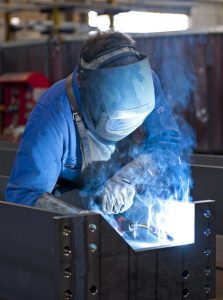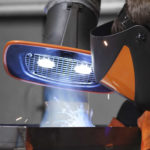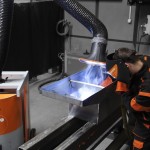MIG welding: highly hazardous despite lower quantities of welding fumes
MIG welding is considered a highly productive and fast welding method and is mainly used when non-iron metals are processed e.g. for plant, apparatus or aircraft manufacturing. In comparison to MAG welding, MIG welding does not use active gases, but unchangeable, inert gases. Mainly argon but in individual cases also the expensive helium assist in protecting the welding seam against oxidation due to external oxygen influence from the air.
However, this is exactly the reason for the welder’s health risk MIG welding is a type of arc welding. The arc is crucial in order to maintain high productivity. This ensures high temperatures and burns the welding wire which is coiled on a spool. This in turn is used on the one hand as live electrode and on the other hand as an auxiliary material. 95% of the hazardous substances created during welding are usually caused by the auxiliary material.
 Carcinogenic despite low emissions
Carcinogenic despite low emissions
MIG welding causes relatively low quantities of welding fumes in comparison to MAG welding, however, the risks can be found when looking at the details. Welding of aluminium materials releases welding fumes which include aluminium oxide. This hazardous substance is classed as risk to lungs and can cause dust deposits in the respiratory tract, above all in the lung itself. Welders can fall ill with an irreversible aluminosis – which in Germany is after all a professional illness liable to compensation. It is less the duration of exposure than the intensity which causes the illness. Irritation of the respiratory tract may occur as well.
It is also necessary to consider the risk of ozone when MIG welding aluminium alloys. The formation of the gas is mainly caused by the arc in combination with a low quantity of welding fumes. The UV rays are obstructed in their spread since less welding fumes are released. Furthermore, they are also reflected by the blank surfaces of aluminium and stainless steel which are the most processed materials. This is how ozone emerges in the environment of the workplace. More dust would promote a greater decay of this unstable gas into oxygen. Inhaling of ozone leads to mucous membrane irritations, acute irritant gas poisoning or pulmonary oedema. Ten times more ozone is created during MIG welding than in the process of WIG welding.
Nickel alloys as auxiliary material highly dangerous
The highest risk factor for auxiliary materials is present when MIG welding nickel or nickel based alloys. If these consist of a high percentage of nickel, then the welding fumes include nickel oxide of up to 87%. Nickel oxide in turn is classed as carcinogenic.
If nickel based alloys also include copper, then you can assume that larger quantities of welding fumes are created in comparison to when working with combinations containing chrome, cobalt or molybdenum. Then copper oxide becomes the main component; it is classed as toxic and may cause metal fever.
In general, the following applies for MIG welding: Despite the lower quantities of welding fumes, all occurring hazardous substances still show a high risk factor for MIG welding – in the same way as welding fumes do.
It is necessary to implement relevant ventilation measures, since a change to processes using less hazardous substances is not possible for MIG welding and workplace improvement does not provide the desired relief from the related hazardous substances. Welders should particularly prefer direct extraction in the generation zone.





